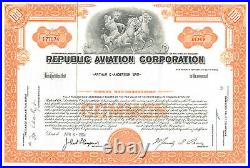

Old Stock Yard Collectible Stock and Bond Certificates. Fantastic vignette of Thor. Originally known as the Seversky Aircraft Company, the company was responsible for the design and production of many important military aircraft, including its most famous products: World War II’s P-47 Thunderbolt fighter, the F-84 Thunderjet and F-105 Thunderchief jet fighters, as well as the A-10 Thunderbolt II close-support aircraft. Seversky Aircraft Company The Seversky Aircraft Company was founded in 1931 by Alexander de Seversky, a Russian expatriate and veteran World War I pilot who had lost a leg in the war. In the beginning, many of Seversky Aircraft’s designers were Russian and Georgian engineers, including Michael Gregor and Alexander Kartveli, who would go on to design many of Republic’s most famous aircraft. After several failed attempts, Seversky Aircraft finally won a design competition for a new United States Army Air Corps fighter, and was awarded its first military contract in 1936 for the production of its Seversky P-35. In 1939, Seversky Aircraft again entered in a military fighter competition, this time with the much improved AP-4. Unfortunately, the contract was instead awarded to the somewhat inferior Curtiss P-40, but the Army Air Corps were very pleased with the aircraft’s medium- and high-altitude performance and ordered 13 additional AP-4s for testing. The board, led by financier Paul Moore, voted W. Wallace Kellett to replace him as president, and in September 1939, the company was reorganized as the Republic Aviation Corporation. Seversky continued to fight for his company, and the matter was not resolved to his satisfaction until September 1942. Meanwhile, Seversky’s AP-4 continued in development, finally going into production as the P-43 Lancer. 272 P-43s were eventually produced, with 108 of them being sent to China to be used against the Japanese. Many passed through the hands of the AVG Flying Tigers, whose pilots were pleased with the plane’s performance at altitudes up to 30,000 ft (9,100 m), while their P-40s were ineffective at altitudes over 20,000 ft (6,100 m). Perhaps Claire Chennault disliked the early P-43’s lack of self-sealing fuel tanks and armor. He declined to retain the plane for his crews. In 1939, both Republic and Curtiss participated in an Army competition to develop a lightweight interceptor. Curtiss submitted a lightweight version of the P-40 designated the XP-46 while Republic submitted a similar design designated the XP-47. Both designs were based on a lightweight aircraft built around an Allison V-1710 V-12 engine, with the Republic design using a turbosupercharger. In the end, neither design showed a significant improvement over the P-40, and neither was produced. Further development of the P-43 continued in the form of a lightweight version using a Pratt & Whitney R-2180 radial engine. The resulting aircraft was known as the XP-44. When the R-2180 did not produce the expected horsepower, Republic switched to the Wright R-2600. Despite possessing 1,600 horsepower (1,200 kW), this engine could not be turbo-supercharged and Republic finally modified the design again, this time to accommodate the enormous Pratt & Whitney R-2800 Double Wasp engine, which produced 1,850 horsepower (1,380 kW). The resulting aircraft, now known as the P-44, was truly impressive. Capable of speeds of 404 mph (650 km/h) at 20,000 ft (6,100 m), and a climb rate of 4,000 ft (1,200 m) per minute, the aircraft would have been an exceptional interceptor. Unfortunately, the aircraft was capable of carrying no more fuel than the P-43, and the Double Wasp engine was far more thirsty, significantly limiting the aircraft’s range. As the air war in Europe progressed, the Army was discovering that what it really needed was a long range fighter capable of escorting bombers into Germany. Alexander Kartveli was called to the Army’s Experimental Aircraft division and told of the new requirements, and that the P-44 would not be ordered in its current configuration. This was a devastating setback for Kartveli and Republic Aircraft because Kartveli knew the XP-44 could not be redesigned to meet these new requirements. On the train back to New York City, he began sketching a new design. This aircraft would become the P-47 Thunderbolt. Old Stock Yard Policies and FAQs. Items are sent via U. Usually first class, but occasionally priority or parcel post. Policy, my listings are setup to accept. Are you your certificates authentic or copies? Everything I sell is original and authentic. I do not sell copies or reproductions. Is the certificate pictured the exact one I will receive? Occasionally, I do list certificates of the same type without rescanning. In this case, the certificate you receive will be virtually identical same color, size, vignette, etc. To the one pictured. What is the best way to store, protect, and display my certificate collection? The best thing, by far, that I have come across for storing certificates are profolios and sleeves made by Itoya. I have several sizes available. Do the certificates you sell have financial value? The item “Republic Aviation Corporation Seversky Aircraft Corporation stock certificate” is in sale since Monday, September 4, 2017. This item is in the category “Coins & Paper Money\Stocks & Bonds, Scripophily\Transportation\Aviation”. The seller is “oldstockyard” and is located in Jacksonville, Florida. This item can be shipped worldwide.

